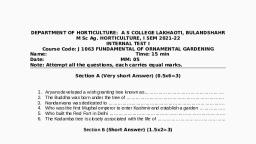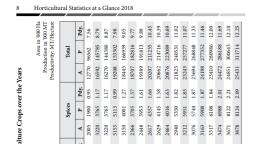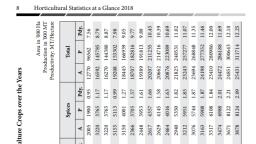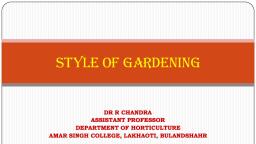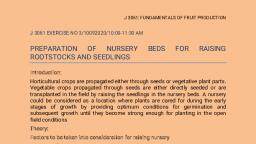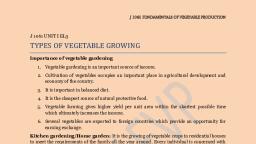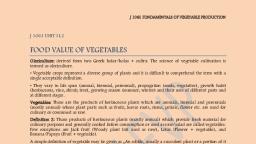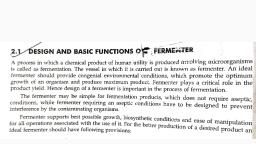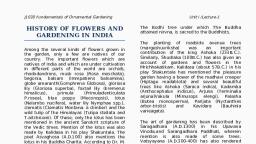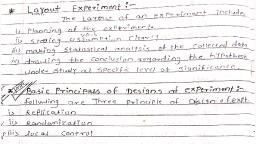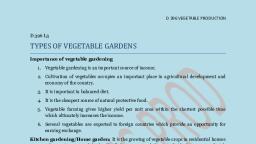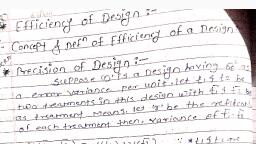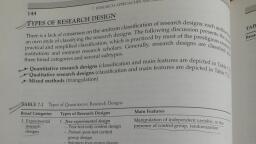Page 1 :
J1030 Fundamentals of Ornamental Gardening, , PRINCIPLES OF GARDEN DESIGN, , A garden may be defined as an, , area established with plants, a valuable, and pleasurable adjunct to a house., , A mere collection of plants will not, make a garden. It is the skillful, arrangement and disposition of plants, over the area making a design or pattern, or picture as it were that forms a garden., The planning of a garden is an art. It is, said that a poet is born, and in that, sance Before planning a design one, must be used for what purpose the, garden is Utility or Beauty or Both., , Initial Approach of Designing a Garden:, In theory, everyone would like to have a, perfect plot of land, but in actual, practice the plot available for gardening,, in three out of five cases, either will not, be in a good site or the shape and size, will not be ideal. Whatever, may be the, case, one should not throw one's hands, up in despair even if the site appears to, be not so good. A good designer is who, will make best use of such a site-. As, has already been stated, land with, natural undulations should never be, leveled, but rather the Differences in, levels should be utilized with advantage., The other terms and principles used in, landscape design are briefly discussed, below:, , Axis :, , This is an imaginary line in any garden, around which the garden is created, striking a balance. In a formal garden,, the central line is the axis. At the end of, an axis, generally there will be a focal, point although other architectural, features such as bird-bath or sundial, can also be created at about the, midpoint., , Focal Point:, , Unit | /Lecture-3, , In every garden there is a center of, attraction which is generally an, architectural feature focused as a point, of interest. A focal point is one of the, elements of good landscape design., Mass Effect:, , The use of one general form of plant, material in large numbers in one place is, done to have mass effect to see that, mass arrangements do not become, monotonous; the sizes of masses, should be varied., , Unity:, , Unity in a garden is very important as, when this is achieved it will improve the, artistic look of the garden. Unity has to, be achieved from various angles., , First, the unity of style feeling, and, function between the house and the, garden has to be achieved, , Secondly, the different components of, the gardens should merge harmoniously, with each other. The aim is to give the, visitor an overall impression of the, garden rather than blowing up some, special features., , The last point, which is also very, important, is to achieve some harmony, between the landscape outside and the, garden., , Space:, , The aim of every garden design should, be such that the garden should appear, larger than its actual size. One way of, achieving this is to keep vast open, spaces, preferably under lawn and, restrict the plantings in the periphery,, normally avoiding, , any planting in the center., , Divisional Lines:, , In a landscape garden, there should not, be any hard and fast divisions lines. But, there is necessity of dividing or rather, screening a compost pit or amali's, quarter or a vegetable garden from the, , 1, , Dr R Chandra, Assistant Professor, Department of Horticulture, A S College, Lakhaoti, BSR, , 2 Edit, , , , PS Office
Page 2 :
J1030 Fundamentals of Ornamental Gardening, , rest of the garden, In fact areas under, lawn, gravel, stone or cement path, and, shrubbery border have their natural, divisional lines from its immediate, neighbour though these are not discreet., This is what is exactly needed. The, divisional lines should be artistic with, gentle curves and these should also be, useful. Above all these lines should be, harmonized with one another., Proportion and Scale:, , Proportion in a garden may be defined, as a definite relationship between, masses., , For example a rectangle having a ratio, of 5:8 is considered to be of pleasing, proportion. As this ratio comes down, the form looks neither in square nor a, rectangle, and the design becomes, undesirable., , Texture:, , The surface character of a garden unit is, referred to as texture. The texture of the, ground, the leaves of a tree or shrub will, all determine the overall effect of the, garden. The texture of rugged looking, ground can be improved to an, appreciable extent by laying, metaculously chosen small pebbles, from fee river beds, if establishing a, lawn is out of the question., , Time and Light:, , In a garden the time factor is very, important there are three different, categories of time in a garden., , First comes the daily time, which, provides different quantities and, qualities of light during the course of the, day. As the morning Sun is vital for all, flowers, the designer has to take this, into account while planning., , Tone and Colour :, , A tendency on the part of an amateur, gardner is to create a riot of colours by, indiscriminately planting _ flowering, , Unit | /Lecture-3, , annuals of all shades. This practice is, not desirable. Moreover, such riot of, colours has only temporary effect. In a, landscape garden, the permanent, backdrop is the green tones of the, various trees and shrubs. It is possible, to lay out a garden with subtle tone of, the entirely white or yellow flowers, but, at the same time making it charming, also. Another important point is that it is, better to have masses of a single colour, against a mixture of colours. A bed of, roses containing only a single colour of, say red, yellow1 or pink has a much, soften tone and beauty than a bed, containing a mixture of colours., Mobility:, , In a temperate country, the garden, changes colour very sharply and, contrastingly from one season to the, other thus symbolizing mobility or, movement. As for example, many trees, is the temperate regions attire, themselves with wonderful hues due to, the changes in their leaf colour in the, autumn’. Then suddenly in the winter, leaves fall and everything goes to rest, bringing an atmosphere of melancholy, and dullness-all around, , Style:, , Lastly, one has to decide about the style, to be adopted for one's garden. Broadly, speaking, every garden lover has to, invent his own style of gardening, commensurate with his budget, taste,, and the nature of the site., , Reference:, http://www.agriinfo.in, , 2, , Dr R Chandra, Assistant Professor, Department of Horticulture, A S College, Lakhaoti, BSR, , 2 Edit with WPS Office




